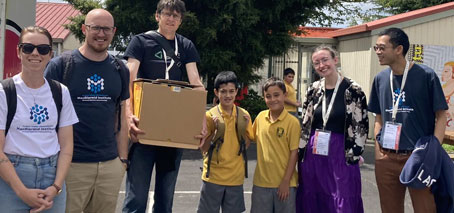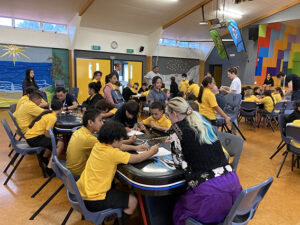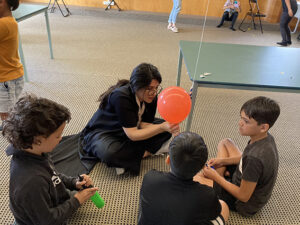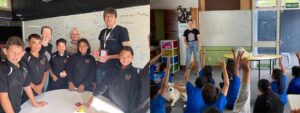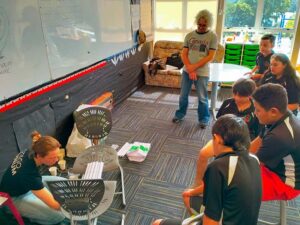
Demonstrating strength of nanotubes, Dr Marijn Kouwenhoven (Tūhura Otago Museum) at rural Whangamarino School
FLEET and MacDiarmid Institute members teamed up at the recent AMN10 conference in Rotorua NZ to conduct science outreach workshops for 320 local school students.
Over four days, 25 volunteers from FLEET and partner organisation the MacDiarmid Institute visited seven schools and presented a variety of hands-on science workshops to students ranging from year 4 to 9, in a program coordinated with Tūhura Otago Museum.
Students got to experiment with the properties of materials at the nanoscale (including oobleck – corn flour slime), and learn about and test the theories that underpin the concepts of forces and energy by building catapults, balloon rockets and graphite circuits.
For many of the schools, this was a rare opportunity for their students to meet and talk with real, practicing scientists about their research, and about science as a career.
Senior students met scientists in an informal ‘People Like Me’ workshop where researchers shared stories about their research and career path, with students asking questions to learn more about the depth, breadth and opportunities in the varied disciplines of science.

Learning about energy with balloon-powered rockets, students at Te Rangihakahaka Centre for Science and Technology
The hands-on workshops were received very positively by students: “I have heard nothing but praise for what you all did with our students. The teachers found it had great value, very engaging, and pitched at the right level for the students…I have been given very positive feedback from all involved.” (Teacher, Westbrook school)
“Thank you all once again for the visit today, the kids loved it.” (Principal, Te Kura Kaupapa Māori o te Koutu)
“Thank you for helping arrange this event for our tamariki. They thoroughly enjoyed this opportunity. Thanks to the facilitators and scientists who did a fantastic job.” (Principal, Te Rangihakahaka Centre for Science and Technology)
Led by Dr Marijn Kouwenhoven from Tūhura Otago Museum (a MacDiarmid Institute outreach partner), and Dr Jason Major and Errol Hunt from FLEET, the students actively engaged with the hands-on activities.
Hands-on activities proved effective. Students thought about what they were observing during the activity, and afterwards most could relate that to the theory provided in the introduction. “For example, students building graphite electrical circuits could explain that the reason their LED got dimmer the further it was from the battery was because the electrons were losing energy as they flowed through the graphite circuit”, says Jason.
At the end of the electrical workshop, students’ thinking shifted to a deeper conceptualization of concepts such as energy and forces. For instance, primary students talked about electrical resistance and the issue of energy consumption (“Computer chips are using too much energy.” “Computers are dying because they lose heat.” “Loss of energy from electrons producing heat.”). They could recall that electrons were like tiny waves, and that power travels through the circuits.
The students were not the only ones learning:
“I probably learned as much as the students,” says Jason Major, FLEET’s outreach coordinator…
“Alongside picking up some good teaching and outreach ideas from our MacDiarmid Institute colleagues, what struck me most about the schools we visited was how strong and well integrated the Māori culture and language was in the local education system and daily life. This includes the Māori-based science that informs kids’ understanding of their environment,” says Jason.
Most schools visited had a student population over 50% Māori, with language, culture and traditional science (matāuranga Māori) explicitly integrated in the curriculum.
“This prompted a discussion among FLEET and MacDiarmid Institute colleagues about how we in Australia could more effectively integrate and embrace this country’s indigenous culture and science in our own science outreach and public engagement,” says Jason.
“In this sense, we can and plan to learn a lot more from our MacDiarmid colleagues.”
MacDiarmid Institute partners also expressed appreciation for FLEET’s contributions:
“I very much appreciated the support and willingness of FLEET and MacDiarmid Institute volunteers who helped us take nano and quantum science to seven Rotorua schools. The outreach effort was extremely well received, with universally enthusiastic feedback from the schools.” (Prof Paul Kruger, Deputy Director Outreach and Engagement, MacDiarmid Institute)
“Partnering with FLEET for the outreach and engagement around AMN10 provided an opportunity to connect up our resources and ideas and build on our intersecting research areas. By combining our outreach content and delivery teams, we were able to more than double the impact of our outreach into the Rotorua schools we visited. We’ve connected our Deputy Director Māori A/Prof Pauline Harris with FLEET and others in the engagement sector in Australia and it’s been interesting and exciting to continue to meet and speak further about engagement with indigenous peoples.” (Vanessa Young, Strategic Engagement and Communications Manager, MacDiarmid Institute)
The team
The FLEET volunteer squad taking time out from the conference to assist were: Karen Bayros and Yik Lee (RMIT) and Golrokh Akhgar (Monash). With special mention to Joshua Gray, who also generously volunteered but was a last-minute victim of mystery illness (not covid; he’s better now, thanks!)
MacDiarmid Institute volunteers were: Sam Harris (University of Otago), Emily Stephens, Geoffrey Weal, Isabella Wagner, Luke Liu, Natalie Plank and Nate Davis (Victoria University of Wellington), Aaron Marshall, Azy Hashemi and Sam Edens (University of Canterbury), Catherine Whitby, Gaby Sansom and Kate Andrew (Massey University) and Anaïs Chalard, Duncan McGillivray, Ira Mautner and Michel Nieuwoudt (University of Auckland).
Coordinators: Dr Marijn Kouwenhoven (Tūhura Otago Museum, for MacDiarmid Institute), Dr Jason Major and Errol Hunt (FLEET)
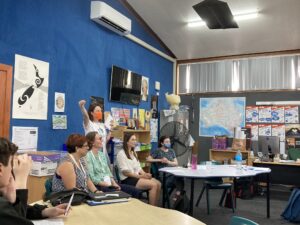
School 1: ‘People like me’ panel at John Paul College, volunteers from left Azadeh Hashemi (University of Canterbury), Kate Andrew and Catherine Whitby (Massey University) and Natalie Plank (Victoria University of Wellington), MCed by Marijn Kouwenhoven (Tūhura Otago Museum).
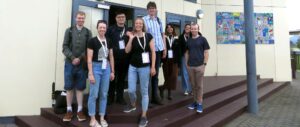
School 2: Westbrook School, with Geoffrey Weal (VUW), Marijn Kouwenhoven (Tūhura Otago Museum), Yik Kheng Lee (RMIT), Isabella Wagner (VUW), Jason Major (FLEET), Karen Bayros (RMIT) , Gaby Sansom (Massey) and Samuel Edens (Canterbury).
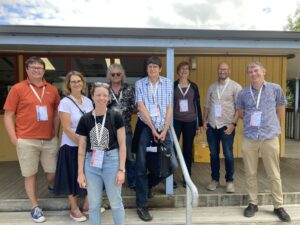
School 3: Te Kura Kaupapa Māori o Te Koutu with Aaron Marshall (Canterbury), Vanessa Young (MacDiarmid Institute), Marijn Kouwenhoven (Tūhura Otago Museum), Errol Hunt and Jason Major (FLEET), Michel Nieuwoudt, Ira Mautner, and Duncan McGillivray (Auckland).
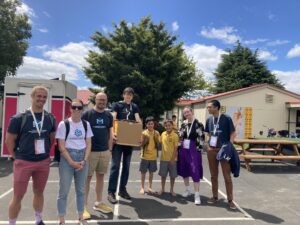
School 4 Rotorua Primary School, with Sam Harris (Otago), Marijn Kouwenhoven (Tūhura Otago Museum), Nathaniel Davis (VUW), Jason Major (FLEET), two future kaipūtaiao, Emily Stephens and Luke Liu (VUW).
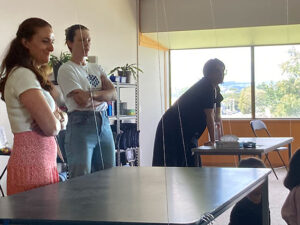
School 5: Te Rangihakahaka Centre for Science and Technology with Anaïs Chalard (Auckland), Marijn Kouwenhoven (Tūhura Otago Museum) and Golrokh Akhgar (Monash).

